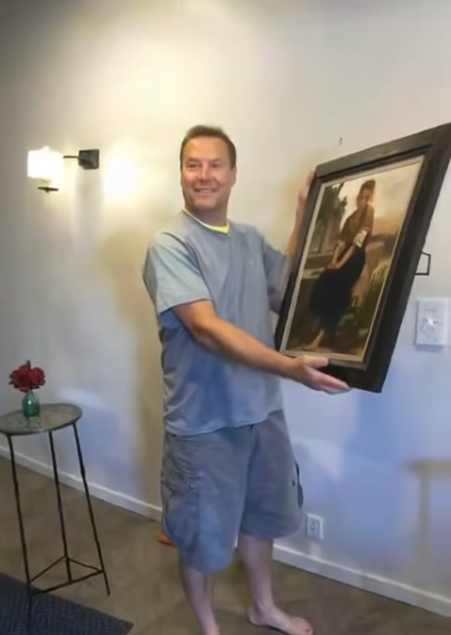I hadn’t planned to stop by the thrift store that day. My wife sent me out for a simple floor lamp—nothing fancy, just enough to keep the living room from feeling like a cave. It was one of those lazy Saturdays where errands are more about getting out of the house than getting things done. I wandered into the old Red Barn Thrift out of habit—sometimes you stumble on a decent record or a coffee table with some life left in it.
That’s when I saw her.
The painting was jammed between a busted mirror and a headboard that looked like it had survived a flood. Easy to miss. The frame was chipped and water-damaged, but what made me stop was her face.
A young woman—maybe 18 or 19—sitting on stone steps, clutching a letter. Her expression wasn’t quite sad, but it wasn’t neutral either. Her eyes were distant, haunted—like you’d caught her in a moment where everything had just shifted, and now she had to live with it.
I let out a quiet laugh. Not because it was funny, but because it felt strangely familiar. I snapped a picture and sent it to my sister with the caption, “Remind you of that girl from ‘98?”
She replied with laughing emojis. “Oh my God. It does look like her.”
I should’ve walked away. I’m not an art guy, and my wife, Lena, has warned me that if I bring home one more “melancholy antique,” I’ll be paying rent for it. But I couldn’t look away.
There was something honest about her.
Before I realized what I was doing, I’d pulled the painting free like I was saving it. Ten bucks later, I was out the door. The cashier didn’t even glance up from his phone.
At home, Lena gave me the usual look. “Really, Cal? Are we running a haunted bed-and-breakfast now?”
I shrugged. “No clue where she’s going. But she’s not staying there.”
I leaned the painting against the office wall for a few days. Every time I passed by, I’d stop. Something about her drew me in.
Eventually, I cleaned the glass, fixed the hardware, and hung her behind my desk. The moment she was up, the room changed. Heavier. Like she brought a presence with her.
About a week later, I had a meeting with a client—Elliot Morse, always sharp, always ahead. He spotted the painting and froze.
“Where did you get that?”
I turned. “That? Some thrift shop in Denton. Why?”
He stepped in like he was examining something priceless. “That’s a Merrin Lowry.”
“A what?”
“The artist. She never got famous, but she should’ve. Sold privately. Estate sales, back rooms. Every piece had the same feel—moody, magnetic.”
He tilted the frame and pointed to a faint marking: ML-073.
“Number seventy-three,” he said. “I’ve been collecting these. I have three. If you’re open to selling—”
I shook my head. “Not this one. But there were more. A whole stack.”
“Would you go back?” he asked. “I’ll pay.”
So the next day, I retraced my steps. Same store, same clutter, same musty smell. I went to the back and found them—seven more paintings, all untouched, all signed the same way.
Lena thought I’d lost my mind.
“You’re turning our house into a shrine to sadness.”
“It’s just a flip,” I said. “Quick resale.”
I sent photos to Elliot. The next day, he was in my office with a large check.
Then came others—collectors in Seattle, Chicago. Within four months, I’d found and sold nineteen more paintings.
Except one.
The first.
She still hangs in my office, watching. Her expression hasn’t changed. It’s not sadness—it’s that moment after the fall, when you’re pretending everything’s fine. She reminds me that meaning isn’t always obvious. Sometimes it whispers. Sometimes it waits for you in a dusty thrift store for ten bucks.
People ask why I kept her. Why not sell the one that started it all?
Because sometimes, the most important things don’t shout. Sometimes, it’s just a girl on stone steps with a letter, daring you to pay attention.
She’s not just a painting anymore. She’s the reason I believe that the unexpected can change your life.
So next time you’re rummaging through the forgotten and overlooked, ask yourself:
What if the thing that finds you… is the thing you didn’t even know you needed?
